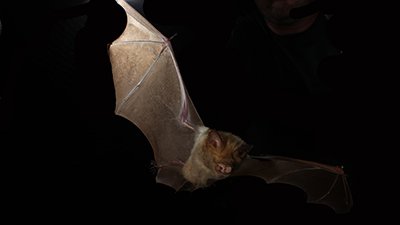
Is This Famous Fish a “Living Fossil”? Well, That Depends on Your Assumptions
Evolutionists consider this famous six-foot fish a “living fossil”—a term steeped in assumptions and fanciful storytelling, not observational science.
Coelacanths aren’t likely to win a beauty contest anytime soon. Featuring dull coloration and white spots, these six-foot-long fish make their home in rocky outcroppings in the deep ocean. Even though they aren’t the flashiest of fish, they might win for being among the most unique, coming equipped with armored scales, paired lobed fins that move in a synchronized fashion (like a helicopter in water!), a hinged skull, an electro-sensory system, and a hollow oil-filled “notochord” backbone. Oh, and they’re also considered “living fossils.”
What is a “living fossil”? This term typically describes a living organism that looks like a fossilized organism but has no close living relatives by evolutionary reckoning. Coelacanths first appear in the fossil record over 300 million years ago, say evolutionists, and were thought to have gone extinct around the time the dinosaurs were supposedly wiped out— until 1938 when a fisherman hauled one up in his net off the coast of South Africa. (Later they were also found off Indonesia, where fishermen were familiar with the fish.) After the sensational discovery, coelacanths were labeled “living fossils” because living coelacanths are stunningly similar to their supposedly 300-million-year-old relatives. In other words, very little “evolution” occurred over hundreds of millions of years.
These unique fish were considered extinct until 1938 when a fisherman hauled one up in his net off the coast of South Africa.
Well, in a new genetic analysis, scientists claim they’ve knocked the coelacanth off its perch as a living fossil. A popular summary of the study states,
An analysis of coelacanth DNA suggests its genome has experienced some significant changes in recent evolutionary history, potentially dispelling the popular image of these iconic fish as being “living fossils.”
The scientists argue that one of the two extant coelacanth species has acquired “dozens of new genes in the past 23 million years.” Therefore, the popular idea that these fish have remained virtually unchanged—due to the remarkable similarity between the living and fossil fish—is wrong, they argue. The fish, they claim, have evolved, gaining dozens of new genes.
But how do they “know” these living coelacanths have dozens of genes their ancestors didn’t have? Well, it’s not because they compared living coelacanth DNA with extinct coelacanth DNA (they can’t, because the DNA is too degraded)—it’s because of their evolutionary assumptions! Geneticist Dr. Georgia Purdom explains further:
The idea that the coelacanth has “acquired dozens of new genes” over millions of years is nothing more than fanciful storytelling to uphold evolutionary ideas. Coelacanths pose a conundrum for evolutionists. Organisms are supposed to evolve or change over time, but coelacanths in the fossil record are very similar to modern, living coelacanths. The authors of this new study propose that while the fossil and living coelacanths may look very similar on the outside, they are genetically quite different. One might expect this knowledge to come from a comparison of the DNA of fossil and living coelacanths, but it doesn’t because the DNA in fossil coelacanths is too degraded.
It merely comes from looking at the DNA from living coelacanths and seeing that they possess genes that have some similarities to a particular family of transposons (known as “jumping DNA” because this DNA can move around in the genome). The evolutionary story is that 62 new genes formed from these transposons over the last 23 million years. However, there is no known mechanism like mutations or natural selection that can result in the formation of new genes either from scratch or from pre-existing DNA sequences. They aren’t even sure what these 62 “new” genes do, and one might expect that with that many new genes, there would be many observable differences between fossil and modern coelacanths and yet there aren’t.
Just because these genes share similarity with a family of transposons doesn’t mean they formed from them. It just means they are similar! That is the observable evidence, but how we interpret that evidence all depends on our worldview.
Coelacanths continue to be a puzzle to evolutionary scientists. This new study is no more than storytelling to try and get around the truth—their kind was created by God on day five of creation week, just a few thousand years ago.
Get More Answers on Answers News
This item was discussed yesterday on Answers News with cohosts Avery Foley, Tim Chaffey, and Dr. Jennifer Rivera. Answers News is our twice-weekly news program filmed here at the Creation Museum and broadcast on my Facebook page and the Answers in Genesis Facebook page. We also covered the following topics:
- Is creationism a conspiracy theory?
- A major pro-life group gets censored by YouTube.
- New teeth rewrite human history . . . again!
- And more!
Be sure to join us each Monday and Wednesday at 2 p.m. (ET) on my Facebook page or the Answers in Genesis Facebook page for Answers News. You won’t want to miss this unique news program that gives science and culture news from a distinctly biblical and Christian perspective.
Thanks for stopping by and thanks for praying,
Ken
This item was written with the assistance of AiG’s research team.
Most Recent News
-
May 2, 2024 from Ken Ham Blog
A recent news article sported the bold claim that evolution in action was recently observed in island bats.
-
April 29, 2024 from Ken Ham Blog
Praise God for parents and organizations in Queensland for coming together and actually keeping their children’s “safety” and “wellbeing” in mind.

Answers in Genesis is an apologetics ministry, dedicated to helping Christians defend their faith and proclaim the good news of Jesus Christ.
- Customer Service 800.778.3390
- © 2024 Answers in Genesis


